Modern automobile design has significant demand for sensors that are vital for many applications. These sensors, along with other components, help car manufacturers in designing and launching car models with greater driving comfort, safety, and fuel efficiency. In the coming years, sensors will also play a vital role in automobile automation and digitalisation. The industry and consumers will benefit greatly from these innovations.
Smart capability to observe
Sci-fi movies have long speculated that the future will be filled with cars that fly and drive on their own. While flying cars may not be a reality, for now, self-driving vehicles are highly likely to happen soon. Car manufacturers are experimenting with the capability of vehicles to observe specific parameters independent of a human operator. Some of these parameters like speed, positioning, temperature, and proximity require devices like a tilt sensor for detection. Much has been achieved over the years regarding this innovation, and there are cars fitted with ultrasonic sensors and cameras that detect the time of flight.
Gesture recognition
The movement towards autonomous car driving will be gradual, and a current precedent to this technology is the use of time of flight cameras. A specific illustration is cars with Advanced Driver Assistance Systems. But despite having this functionality, these cars still require human intervention at any given moment when needed.
Consumers expect the industry to increase automation in the coming years, but still allow drivers to resume control especially when the car is in heavy traffic locations. Even then, this will be a considerable step-up to the technology. Time of flight technology will be the answer to complete automation, albeit it is still in the early stages. Right now, this function is helping alert drivers when the vehicle is drifting off the road.
Traffic 3D mapping
Cruise control systems in cars today are already capable of measuring how a vehicle is distanced to a car in front of it. But this technology suffers in high traffic and urban scenarios where variables such as pedestrians or smaller roads affect the capability of the system to provide precise measurements.
One of the possible solutions is adding cameras for determining perspective. Unfortunately, the available image processing technology today is not sophisticated enough to provide the required reliability needed to guaranty safety in driving. Another potential solution is the use of lidar. Lidar works similar to radar, but instead of detecting radio waves, lidar uses light beams or lasers. One of the advantages of using lidar is the capability to detect smaller objects which radar cannot identify.
Compared to cameras, lidar renders images in 3D. By using 3D rendered images, lidar can help a car isolate which objects are in front and which are behind. This technology works regardless of the lighting condition.
Conclusion
As the automobile manufacturing industry moves toward greater automation, next-generation sensors will help make this capability a reality. The cars of the future will not only become more efficient but also have enhanced features that help detect and differentiate the external environment and achieve safer transport.














Be First to Comment